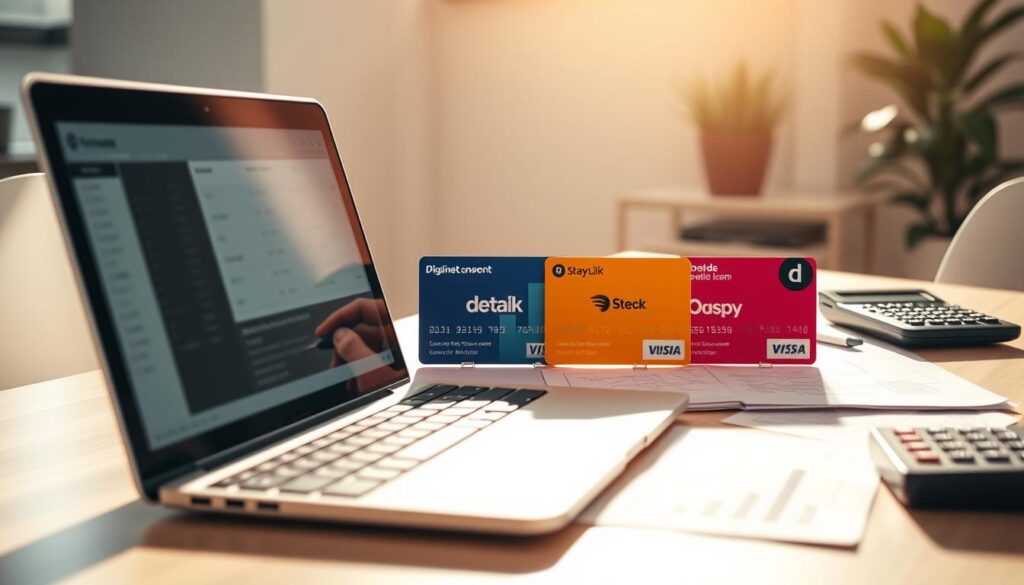Low Interest Personal Loans: Find the Best Rates
Did you know rates starting at 6.49% APR are available for personal loans up to $50,000 or more? This makes competitive interest rates more accessible than ever for individuals seeking affordable financing solutions.
We will explore how these low interest personal loans can be a viable option for you. Our discussion will cover the benefits of such loans and guide you on finding the best personal loan rates available in the market.
Key Takeaways
- Competitive APR rates starting at 6.49%
- Loan amounts available up to $50,000 or more
- Understanding factors that influence interest rates
- Tips for finding the best personal loan rates
- Benefits of choosing low interest personal loans
Understanding Low Interest Personal Loans
Low interest personal loans are a great choice for those who need money but don’t want to spend too much. They offer affordable personal finance options for people in need.
What Are Low Interest Personal Loans?
These loans let you borrow money at a lower interest rate than usual. Companies like LightStream and SoFi have competitive rates. For example, LightStream’s rates start at 6.49% APR. This makes them a good online personal loan option for those with good credit.
Benefits of Low Interest Personal Loans
The main advantage of these loans is the lower cost of borrowing. With lower APRs, you save on interest over time. This is great for those looking to consolidate debt or buy big things.
Also, these loans often have better terms. You might get longer to pay back or lower fees. This helps you manage your payments better and avoid financial trouble.
How They Differ from Other Loan Types
Low interest personal loans are different from other loans in a few ways. They usually have competitive interest rates compared to credit cards or payday loans.
Another difference is that they are often unsecured. This means you don’t have to put up collateral to get the loan. It’s a safer option for those who don’t want to risk losing their assets.
Who Can Benefit from Low Interest Personal Loans?
Low interest personal loans are not just for a few. They can help many people. These loans offer lower monthly payments and less interest over time.
Individuals with Good Credit
Those with good credit get the best rates on personal loans. Good credit means a score of 700 or higher. Borrowers with good credit can compare low interest loan offers to find the best deal.
Good credit borrowers can use these loans for many things. This includes paying off debt, buying big items, or covering unexpected costs.
Benefits for Those with Fair Credit
Good credit isn’t the only thing that matters. Lenders like Upstart and LendingPoint offer good rates to those with fair credit. Fair credit is 650 to 699. These borrowers might not get the lowest rates but can still get a good deal.
For fair credit borrowers, it’s key to shop around. Compare offers from different lenders to find the best rate.
Use Cases for Personal Loans
Personal loans are flexible and can be used in many ways. They are cheap personal loans compared to other credit options. People use them to consolidate debt, finance home improvements, or pay for medical bills.
Understanding the different uses and comparing offers helps borrowers make smart choices. This ensures they meet their financial needs.
How to Qualify for Low Interest Personal Loans
To get a low interest personal loan, you need to know what lenders look for. They check several important things to see if you’re a good candidate.
Credit Score Requirements
Lenders really look at your credit score. A high score means you’ve handled money well in the past. For example, LendingClub wants a score of at least 600 to consider your loan.
Usually, a score of 700 or more is needed for the best rates. Here’s how scores affect your rates:
| Credit Score Range | Interest Rate Range |
|---|---|
| 600-650 | Higher than 10% |
| 650-700 | 8%-10% |
| 700-750 | 6%-8% |
| 750+ | Below 6% |
Income Verification and Documentation
Lenders also check if you can pay back the loan. They look at your income by asking for things like pay stubs and bank statements. They want to see that you have a steady income.
Key documents for income verification are:
- Recent pay stubs
- Bank statements
- Tax returns (for self-employed)
Other Factors Lenders Consider
Lenders also look at your debt-to-income ratio, job history, and if you have collateral for secured loans. A lower debt ratio and a steady job can help you qualify better.
Knowing what lenders want can help you get ready. By improving your financial situation, you can get better loan terms.
Where to Find Low Interest Personal Loans
Looking for low interest personal loans starts with knowing your options. Today, you can find competitive rates through many channels online.
Online Lenders vs. Traditional Banks
Online lenders like Upgrade and SoFi have changed the game. They offer competitive rates and flexible terms. Their lower costs mean they can give you better deals.
Traditional banks, on the other hand, offer security and a personal touch. You can get personalized service and possibly negotiate better terms.
- Online lenders: Quick application, competitive rates, and flexible terms.
- Traditional banks: Personal service, negotiation options, and security.
Credit Unions and Community Banks
Credit unions and community banks are often missed but are great for low interest personal loans. They focus on serving their community, not just making money. This means better terms for you.
They might have easier qualification and lower rates. This makes them a good choice if you have good credit or a strong community tie.
Comparison Sites for Loan Rates
Comparison sites are a smart way to compare low interest loan offers. They collect data from different lenders. This lets you quickly find the best loan for you.
When using these sites, look at more than just the interest rate. Consider the loan terms, fees, and how you’ll repay it.
How to Compare Loan Offers
When looking for the best low interest personal loans, comparing offers is key. This means looking at several important factors. This ensures you get the most affordable personal finance options.
Interest Rates and APRs
The interest rate and Annual Percentage Rate (APR) are vital in a loan offer. The interest rate shows the cost of borrowing. But, the APR includes extra fees and charges, giving a clearer picture of the loan’s total cost.
For example, SoFi’s APR ranges from 8.99% to 35.49%. Some loans also have an origination fee. It’s important to look at both the interest rate and APR to get the loan’s true cost.
Loan Terms and Conditions
Loan terms and conditions greatly affect your borrowing experience. It’s important to check the loan term, repayment schedule, and any flexibility the lender offers.
Here’s a comparison of loan terms from different lenders:
| Lender | Loan Term | Repayment Flexibility |
|---|---|---|
| SoFi | 2-7 years | Yes, flexible repayment options |
| LightStream | 2-7 years | No prepayment penalties |
| Discover Personal Loans | 3-7 years | Yes, flexible repayment terms |
Fees and Penalties to Watch For
Lenders may charge various fees, like origination fees, late payment fees, and prepayment penalties. Knowing these fees is crucial to avoid surprise costs.
For instance, some lenders might charge an origination fee of 1% to 8% of the loan amount. Always check the loan agreement for any fees or penalties.
By comparing loan offers based on interest rates, APRs, loan terms, and fees, you can make a smart choice. This way, you can find the best low interest personal loan for your needs.
Tips for Getting the Lowest Rates
Low interest personal loans can be a great financial tool. But, getting the lowest rate takes some effort. It’s key to know what lenders look for in loan applications.
Improving Your Credit Score
Improving your credit score is a top way to qualify for low interest personal loans. Lenders see high credit scores as less risky. This can mean better loan terms for you.
To boost your credit score, pay bills on time. Reduce your debt and avoid new credit checks.
For more tips on qualifying for low interest personal loans, check out Bankrate’s guide.
Considerations for Secured vs. Unsecured Loans
When applying for a personal loan, you can choose between secured and unsecured loans. Secured loans need collateral, which can be taken if you can’t pay back the loan. They might have better interest rates, but they risk your assets.
Unsecured loans don’t need collateral but might have higher rates. This is because lenders see them as riskier.

Timing Your Application
The timing of your loan application can affect the interest rate. Lenders might offer better rates during certain times, like promotions. Also, applying when you have a stable income and low debt can help you get the best personal loan rates.
By understanding these factors and improving your application, you can get a loan with a low interest rate. This helps you get a loan with low interest.
Misconceptions About Personal Loans
Many people have wrong ideas about personal loans. These ideas can lead to bad financial choices. It’s important to know the truth aboutcheap personal loansandonline personal loan options.
Common Myths Debunked
One myth is that personal loans are only for those with perfect credit. But, many lenders offer good rates to people with different credit scores. For example, some lenders help those with fair or average credit, making loans more available.
Another myth is that personal loans are too pricey because of high interest rates. While some rates are high, many lenders offercompetitive interest ratesto those with good credit. By comparing rates, you can save a lot of money.
“The key to getting a good deal on a personal loan is understanding the terms and conditions before signing.”
The Truth About Loan Terms
It’s crucial to understand loan terms when you apply. Loan terms can differ a lot between lenders. Some offer flexible plans, while others are stricter. Always check the interest rate, repayment period, and fees carefully.
Here’s a table showing different loan terms:
| Lender | Interest Rate | Repayment Term | Fees |
|---|---|---|---|
| Lender A | 6.99% | 36 months | $0 origination fee |
| Lender B | 8.99% | 60 months | $100 origination fee |
| Lender C | 5.99% | 24 months | $50 origination fee |
Understanding the Fine Print
The fine print of a personal loan includes fees, penalties, and repayment terms. It’s important to read and understand this to avoid surprises. For example, some lenders charge penalties for early repayment, while others don’t.
Knowing the truth about personal loans helps you make better choices. Look forcheap personal loansandonline personal loan optionswithcompetitive interest rates. Always review the loan terms and ask questions if you’re unsure.
Managing Your Loan After Approval
Managing your low-interest personal loan after approval is key to keeping your finances healthy. After getting the loan, focus on repaying it to avoid financial trouble.
Setting Up a Payment Plan
To manage your loan well, setting up a payment plan is crucial. You need to know the loan’s terms, like the interest rate and how long you’ll pay it back. Use a loan repayment calculator to find the best payment plan for you.
When making a payment plan, think about your income and expenses. This helps make sure your monthly payments are doable. Setting up automatic payments can also help you avoid missing payments.
Strategies for Early Repayment
Paying off your loan early can save you money and reduce your debt. Strategies for early repayment include making extra payments or paying more than the minimum each month. We’ll look at these strategies to help you use them effectively.
One good strategy is to make bi-weekly payments instead of monthly ones. This means you’ll make 26 payments a year instead of 12, shortening your loan term. You can also use windfalls, like tax refunds or bonuses, to pay off your loan.
Dealing with Financial Hardships
Financial troubles can come out of nowhere, making it hard to pay your loan. If you’re facing hard times, it’s important to talk to your lender about possible solutions.
Lenders might offer forbearance or deferment options to help. These options can temporarily stop or lower payments. It’s important to understand these options and their effects on your loan. We suggest reviewing your loan agreement and talking to your lender to find a solution that works for you.

Frequently Asked Questions About Low Interest Personal Loans
When looking into low interest personal loans, many questions come up. We’ll answer some common ones to help you make a smart choice. This is for those exploring online personal loan options.
Borrowing Amounts
Loan amounts can differ a lot, with some lenders offering up to $100,000. How much you can borrow depends on your credit score and other factors. Lenders look at these when deciding if they can lend to you.
Understanding Interest Rates
Interest rates on personal loans depend on your credit score and other things. To get the best rates, having a good credit history is key. Lenders use this to figure out the risk of lending to you.
Approval Times
How fast you get approved for a low interest personal loan varies. It can take a few hours to several days, depending on the lender and your application. Online lenders usually make decisions faster than banks.
Knowing these details helps you find a low interest personal loan that fits your financial needs.









